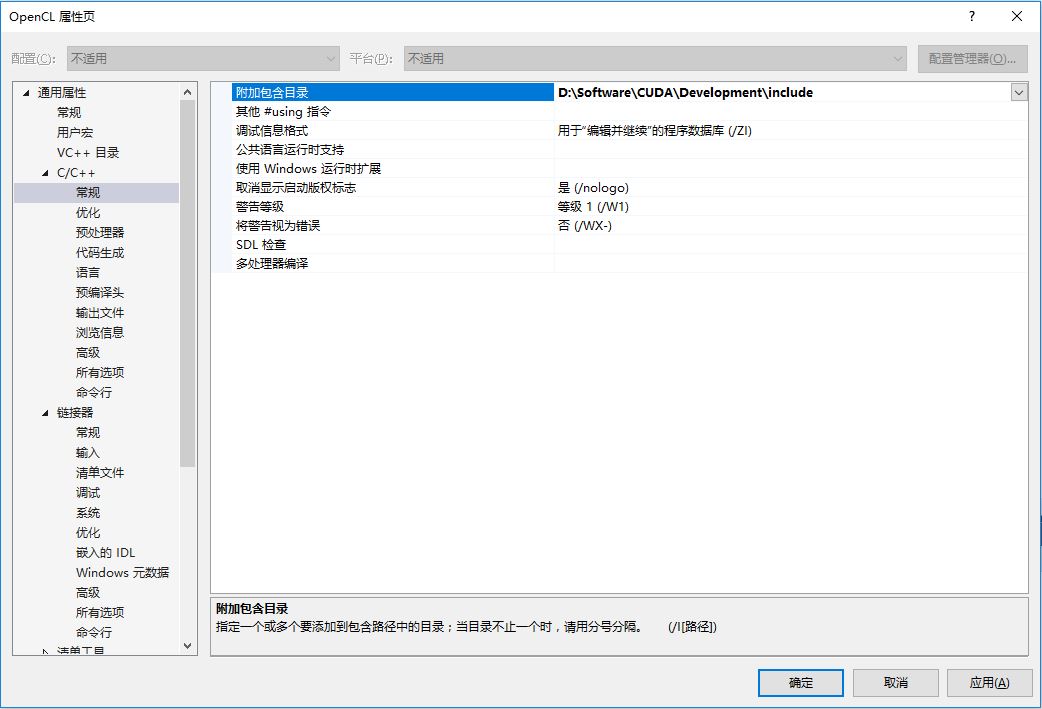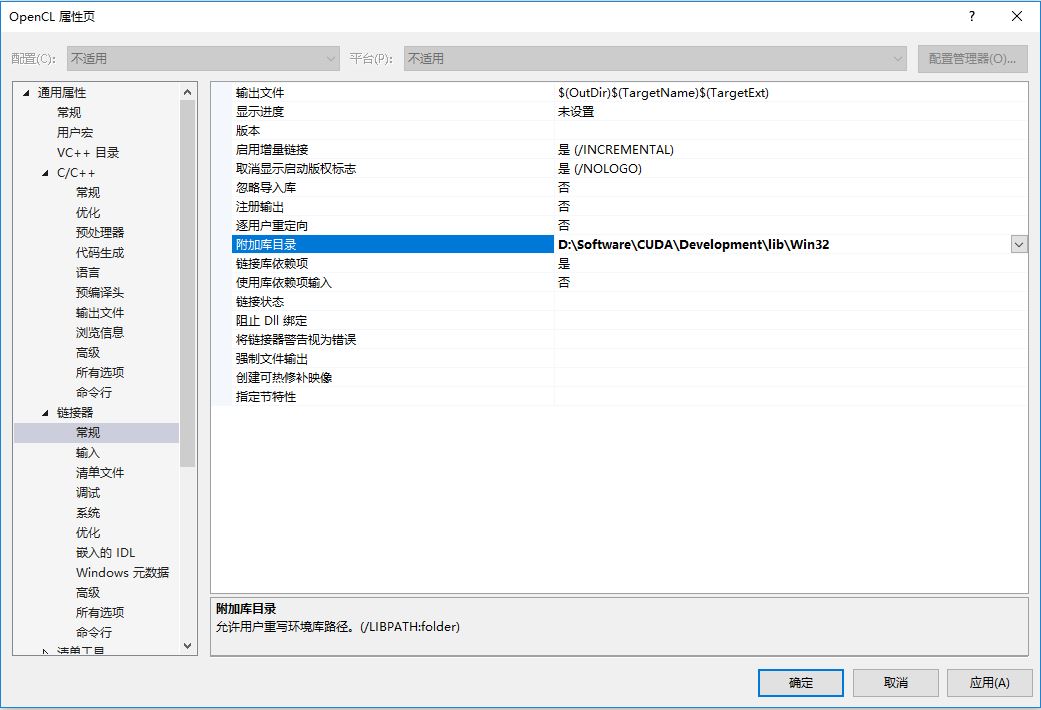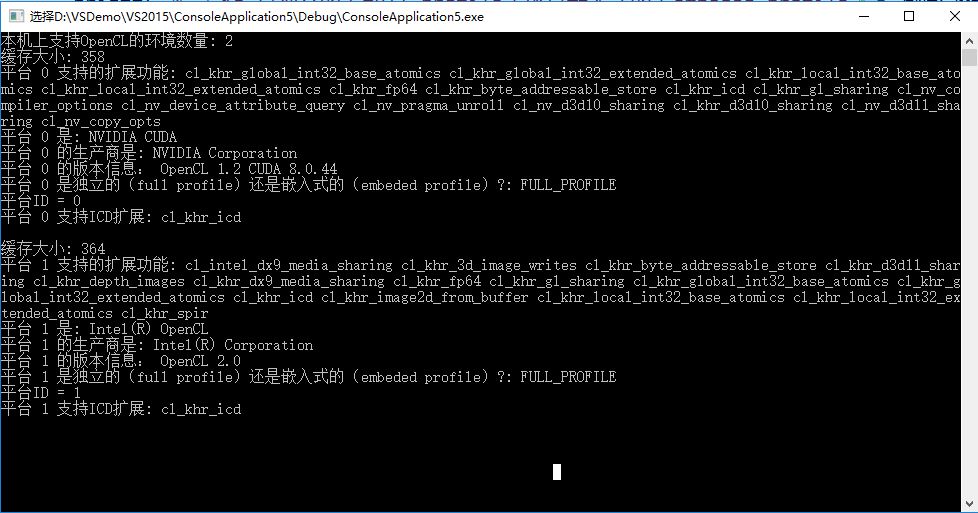英伟达的显卡首先要下载安装CUDA开发包,可以参考这里的步骤: VS2015编译环境下CUDA安装配置
安装好CUDA之后,OpenCL的配置就已经完成了80%了,剩下的工作就是把OpenCL的路径添加到工程中。
1. 新建一个win32控制台应用程序,在工程的属性管理器Debug中添加一个属性页“OpenCL.props”,之后双击打开
2. 在C/C++ ->常规->附加包含目录 中添加CUDA的include文件夹路径,我的路径是“D:SoftwareCUDADevelopmentinclude”
3. 在链接器->常规->附加库目录 中添加lib文件夹路径,我的路径是“D:SoftwareCUDADevelopmentlibWin32”
4. 在链接器->输入->附加依赖项 里添加lib文件 OpenCL.lib
经过以上4个步骤,OpenCL编译环境就已经配置好了,可以把属性页“OpenCL.props”保存起来,下次直接这个属性页就可以了,不用每次都重复配置。以下是测试程序:
#include <stdio.h>
#include <stdlib.h>
#include <iostream>
#include <CL/cl.h>
int main()
{
//cl_platform 表示一个OpenCL的执行平台,关联到GPU硬件,如N卡,AMD卡
cl_platform_id *platforms;
//OpenCL中定义的跨平台的usigned int和int类型
cl_uint num_platforms;
cl_int i, err, platform_index = -1;
char* ext_data;
size_t ext_size;
const char icd_ext[] = "cl_khr_icd";
//要使platform工作,需要两个步骤。1 需要为cl_platform_id结构分配内存空间。2 需要调用clGetPlatformIDs初始化这些数据结构。一般还需要步骤0:询问主机上有多少platforms
//查询计算机上有多少个支持OpenCL的设备
err = clGetPlatformIDs(5, NULL, &num_platforms);
if (err < 0)
{
perror("Couldn't find any platforms.");
exit(1);
}
printf("本机上支持OpenCL的环境数量: %d
", num_platforms);
//为platforms分配空间
platforms = (cl_platform_id*)
malloc(sizeof(cl_platform_id) * num_platforms);
clGetPlatformIDs(num_platforms, platforms, NULL);
//获取GPU平台的详细信息
for (i = 0; i < num_platforms; i++)
{
//获取缓存大小
err = clGetPlatformInfo(platforms[i],
CL_PLATFORM_EXTENSIONS, 0, NULL, &ext_size);
if (err < 0)
{
perror("Couldn't read extension data.");
exit(1);
}
printf("缓存大小: %d
", ext_size);
ext_data = (char*)malloc(ext_size);
//获取支持的扩展功能
clGetPlatformInfo(platforms[i], CL_PLATFORM_EXTENSIONS,
ext_size, ext_data, NULL);
printf("平台 %d 支持的扩展功能: %s
", i, ext_data);
//获取显卡的名称
char *name = (char*)malloc(ext_size);
clGetPlatformInfo(platforms[i], CL_PLATFORM_NAME,
ext_size, name, NULL);
printf("平台 %d 是: %s
", i, name);
//获取显卡的生产商名称
char *vendor = (char*)malloc(ext_size);
clGetPlatformInfo(platforms[i], CL_PLATFORM_VENDOR,
ext_size, vendor, NULL);
printf("平台 %d 的生产商是: %s
", i, vendor);
//获取平台版本
char *version = (char*)malloc(ext_size);
clGetPlatformInfo(platforms[i], CL_PLATFORM_VERSION,
ext_size, version, NULL);
printf("平台 %d 的版本信息: %s
", i, version);
//查询显卡是独立的还是嵌入的
char *profile = (char*)malloc(ext_size);
clGetPlatformInfo(platforms[i], CL_PLATFORM_PROFILE,
ext_size, profile, NULL);
printf("平台 %d 是独立的(full profile)还是嵌入式的(embeded profile)?: %s
", i, profile);
//查询是否支持ICD扩展
if (strstr(ext_data, icd_ext) != NULL)
platform_index = i;
std::cout << "平台ID = " << platform_index << std::endl;
/* Display whether ICD extension is supported */
if (platform_index > -1)
printf("平台 %d 支持ICD扩展: %s
",
platform_index, icd_ext);
std::cout << std::endl;
//释放空间
free(ext_data);
free(name);
free(vendor);
free(version);
free(profile);
}
if (platform_index <= -1)
printf("No platforms support the %s extension.
", icd_ext);
getchar();
//释放资源
free(platforms);
return 0;
}在本机上执行输出:



